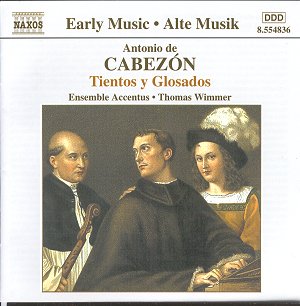Antonio De CABEZON (1510-1566)
Tientos y Glosados
 Ensemble Accentus/Thomas
Wimmer
Ensemble Accentus/Thomas
Wimmer
Recorded March 1997, Karthouse, Mauerbach, Austria
 NAXOS 8.554836
[53.21]
NAXOS 8.554836
[53.21]
Crotchet
AmazonUK
AmazonUS
Amazon
recommendations

Thomas Wimmer, the only member of the Ensemble Accentus to be named by Naxos,
writes the excellent programme notes to this most enjoyable recording. He
tells us that Antonio Cabezon was a blind organist and composer who became
very influential and who worked in the highest circles. From 1539 he travelled
extensively with the Court of, amongst others, Emperor Charles V. It was
this Emperor who added extensively to the Alhambra Palace in Granada.
The Charles V palace is an extraordinary piece of architecture, a circular
court in a square building superbly appropriate for music and drama. Cabezon
must have known this building intimately. His surviving music however is
entirely for keyboard, and on many other recordings where he has so often
been anthologised, it is the occasional harpsichord work, which makes an
appearance. Normally it is the same pieces like the 'Pavana Italiana', or
the 'Diferencias sobre el canto del Caullero'. Yet this palace contained
musicians of all types, and that included instrumentalists.
Quoting Wimmer: "For a long time it had been usual for vocal parts to be
accompanied and reinforced by corresponding instruments, such as cembalo,
harp, viols, flute and others. As a result…the step towards a performance
of an original vocal piece in a purely instrumental version is not too far."
He goes on to say that keyboard works were almost certainly played
instrumentally, indeed we might say, orchestrated, for whatever was at hand.
He adds "the nobility played string and keyboard instruments". Antonio's
son, Hernando, who had his father's music published in 1578 comments, in
the first edition, that there should be a "freer handling of
instrumentation…. Cembalo, harp and vihuela" There is no proof that
Cabezon ever heard his music played like this. Not only is each piece for
a different instrumental combination, but within each piece the instrumentation
changes. There are convincing arguments for it, not the least of which is
the sheer beauty of the end result.
To my knowledge this is the first CD to be completely devoted to Cabezon's
music. ( I must add that there is a piece by Juan de Cabezon, one of only
two works by Antonio's brother, and one by Hernando, the composer's son already
mentioned. This has been put in to show how variation technique developed
after the great man's death. However it is not the first time that Cabezon's
music has been treated instrumentally. Jordi Savall has been doing it since
the mid-'80s on occasional recordings, but more recently Capriccio Stravagante
directed from the keyboard by Skip Sempe has done similar things on a CD,
which came out in September 2000 (Astree Naïve E8651 'The Tradition
of Cabezon'). He recorded ten of the pieces we hear here but mostly at a
more leisurely pace, and with a more string-dominated ensemble. The recording
is not so 'in your face' as this Naxos one. The results are very beautiful
but not so exciting and colourful.
Cabezon's music falls into six categories; 1. 'Diferencias', variations on
popular dance melodies. 2. Glosas, ornamentations of chansons and madrigals
popular at the time, 3. Tiento, related to touch pieces (Toccatas) free,
fantasia forms. 4. Fabordones: embellishments of Hymns and plainchant. 5.
Himnos, harmonisations of chant melodies and 6. Versillos, short harmonised
choral passages; all of these are represented on this recording.
There is no doubt that Naxos Early Music department is striking out into
some fascinating areas, and they have found fine musicians to take us into
some exciting repertoire. Highly recommended.
Gary Higginson

